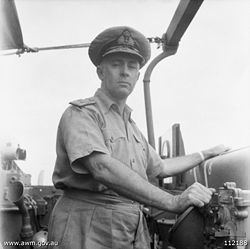Allegiance Australia Rank Rear admiral | Name Harold Farncomb Years of service 1912–1951 Other work Barrister, Solicitor | |
 | ||
Nickname(s) Uncle Hal, Fearless Frank Born 28 February 1899North Sydney, New South Wales ( 1899-02-28 ) Commands held HM Australian Squadron (1944–45, 1946–49)HMS Attacker (1944)HMAS Australia (1941–44)HMAS Canberra (1940–41)HMAS Perth (1939–40)HMAS Yarra (1937–38) Battles/wars First World WarSecond World WarBattle of the AtlanticBattle of the MediterraneanBattle of the Coral SeaGuadalcanal CampaignBattle of the Eastern SolomonsBattle of Cape GloucesterBattle of LuzonInvasion of Lingayen Gulf Awards Companion of the Order of the BathDistinguished Service OrderMember of the Royal Victorian OrderMentioned in Despatches (3)Navy Cross (United States)Commander of the Legion of Merit (United States) Died February 12, 1971, New South Wales, Australia Battles and wars | ||
Rear Admiral Harold Bruce Farncomb (28 February 1899 – 12 February 1971) was a senior officer in the Royal Australian Navy (RAN) who served in the First and Second World Wars, and as a lawyer. He was the first Australian-born RAN officer to reach a flag rank in the RAN. The Collins class submarine HMAS Farncomb is named in his honour.
Contents
Early life
Harold Farncomb was born in North Sydney, New South Wales on 28 February 1899, the second child of Frank Farncomb and Helen Louisa Farncomb, née Sampson. The family lived in Gordon on the north shore of Sydney. He attended Gordon Public School and Sydney Boys' High School before entering the Royal Australian Naval College (RANC) at age 13 in the RANC's first intake. Farncomb excelled academically at the RANC, graduating with very impressive scores and topped his final year (1916). On completing his studies at the RANC he was promoted to midshipman on 1 January 1917 and left immediately on the steamer Naldera for training with the Royal Navy. Farncomb was stationed on board the battleship HMS Royal Sovereign in April 1917.
Naval career
Farncomb served on Royal Sovereign until shortly after the end of World War I. On leaving Royal Sovereign Farncomb was promoted to sub-lieutenant and sent to HMS Excellent on Whale Island for course training. After completing training at Whale Island Farncomb was transferred to Woolsher, a small craft attached to the destroyer force at the Firth of Forth. He then received his first posting in Australia; stationed on board HMAS Stalwart for a year as a gunnery officer, this posting was followed by a year on the staff of Commodore Percy Addison, Commodore Commanding the Australia Squadron (CCAS). In May 1925, after a 10-month war staff course in the United Kingdom, he took a posting as a staff officer (operations) with the CCAS.
Post-military life
Farncomb left the service in 1951 and learned Latin to enable him to study for the Barristers' Admission Board examinations. Admitted to the Bar on 6 June 1958, he developed a reasonably busy practice in Sydney and subsequently joined the solicitors, Alfred Rofe & Sons. A street in the town of Narooma is named in Farncomb's honour.
Heart disease eventually led to his retirement.
Personal life
On 31 March 1927 at Trinity Congregational Church, Strathfield, Sydney, he married Jean Ross Nott; they were to remain childless. "Jean provided staunch support throughout the vicissitudes of her husband's career".
Retirement and death
Survived by his wife, Farncomb died of heart failure on 12 February 1971 in St Vincent's Hospital, Darlinghurst, and was cremated with Anglican rites. His ashes were scattered at sea on 2 March from the flight deck of his last flagship, HMAS Sydney, off the coast of Western Australia.
